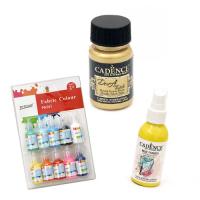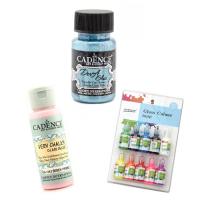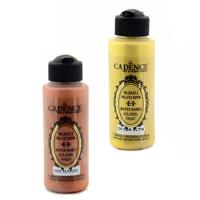Paints and Dyes for Art and Hobby

Set of Fabric Paints 12 Colors x 10 ml, 1 x 30 ml Color Regulator, and 1 Brush

Watercolor Paints with Pointed Brush and Water Reservoir - 18 Colors

Body Paint LORKA 35 grams - Orange Color 004

Body Paint LORKA 35 grams - Black Color 006

Body Paint LORKA 35 grams - Red Color 005

Body Paint LORKA, 35 grams - White Color 007

Body Paint LORKA 35 grams - Blue Color 002

Body Paint LORKA 35 grams - Green Color 003

Body Paint LORKA 35 grams - Yellow Color 001

Body Paint LORKA 35 grams - Flesh Color 008

Acrylic Paint with Gold Glitter / CADENCE GLITTER HYBRID 120 ml - BLACK HSA-060

Acrylic Paint with Silver Glitter / CADENCE GLITTER HYBRID 120 ml - BLACK HSG-060

Acrylic Paint with Silver Glitter / CADENCE GLITTER HYBRID 120 ml - WHITE HSG-001

MM Poster Paint - Fluoro Yellow 500 ml

MM Metallic Watercolour Cake Set with Brush, 16 Colors

Premium Iridescent Foil Paint MONT MARTE, 20 ml

Mont Marte Silver Foil Paint, 20 ml

Mont Marte Super Cell Acrylic Pouring Paint, Light Aquamarine, 240 ml

Mont Marte Super Cell Acrylic Pouring Paint, Light Purple, 240 ml

Mont Marte Super Cell Acrylic Pouring Paint, Hot Pink, 240 ml

Watercolor Cake Set MM, 13 Colors and Soft Bristle Brush

MM Watercolour Painting Set, 26 Colors

MM Fabric Paint Sticks, 9 Pieces

Set of Acrylic Paints / 18 colors x 12 ml
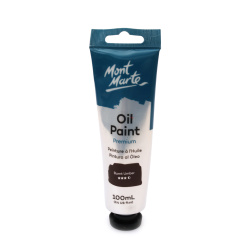
Mont Marte Oil Paint 100 ml - Burnt Umber

MONT MARTE Oil Paint Premium / 100 ml - Gold

MONT MARTE Oil Paint Premium / 100 ml - Zinc White

Mont Marte Oil Paint 100 ml - Sap Green

MONT MARTE Oil Paint Premium / 100 ml - Red Ochre

Mont Marte Oil Paint 100 ml - Silver

Mont Marte Oil Paint 100 ml - Viridian

MONT MARTE Oil Paint Premium / 100 ml - Paynes Gray

Mont Marte Studio Acrylic Paint 500 ml - Silver

MONT MARTE Oil Paint Premium / 100 ml - Naples Yellow

MONT MARTE Oil Paint Premium / 100 ml - Raw Umber (Brown)
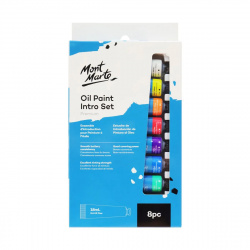
Mont Marte Oil Paint Intro Set 8 colors x 18 ml

MONT MARTE Oil Paint Premium / 100 ml - Permanent Green

MONT MARTE Oil Paint Premium / 100 ml - Carmine

Mont Marte Oil Paint 100 ml - Neutral Gray

MONT MARTE Tempera (Poster) Paint / 500 ml / Yellow

Mont Marte Oil Paint 100 ml - Flesh Tone

MONT MARTE Oil Paint Premium / 100 ml - Mars Black

MONT MARTE Oil Paint Premium / 100 ml - Purple

MONT MARTE Oil Paint Premium / 100 ml - Raw Sienna (Yellow-brown)

Mont Marte Oil Paint 100 ml - Olive Green

MONT MARTE Oil Paint Premium / 100 ml - Burnt Sienna (Reddish Brown)
The Glittering World of Paints for Painting and Decoupage
Our assortment is very diverse.
Among the different paints for painting, you will find:
- watercolors
- acrylics in all their varieties
- poster paints
- paints for candles
- glass paints
- oil paints
- tempera paints
- fabric paints
- spray paints
- stains and glosses
How to Paint with Watercolors?
The watercolor technique is amazingly pleasant and relaxing. It is very effective and beautiful due to all the shades of colors that blend into each other from more transparent to saturated and dense tones.
If you really want to learn to paint with watercolors, you should prepare for a very long journey and a lot of new information, if you haven’t painted with this material before.
The selection of paper you will paint on is very important, as different papers provide different possibilities. The good thing about watercolor is that the base - the sheets of cardboard - is relatively light and easily portable.
This way, you can go anywhere and in just a few minutes create your work atmosphere – whether it will be in nature, in a square in front of some architectural landmark you like, or in another beautiful and favorite place of yours, it doesn’t matter; the choice is yours.
It is very important for the sheet of paper to stay stretched while you work - you can tape it with weaker masking tape and then you are ready to start.
Sketch or Not?
A sketch is not mandatory, especially if your painting will be more emotional or you just want to relax. But if you want to paint something specific, it would be best to start with a pencil to sketch the outlines of the objects you will paint.
If you don’t want the pencil and outlines you placed to be visible in your final painting, you can use watercolor pencils, which will give you the ability to wash out the outlines when you go over them with paint, allowing them to blend into the painting.
From Light to Dark
This is one of the main rules in watercolor painting. It is very important to always start with the light areas of the painting and gradually darken. This method is due to the fact that once you paint something on the sheet, you cannot erase it, nor can you cover it with another color and continue anew or change it as with other techniques.
For this reason, you always start from the light areas and gradually move to the darker ones.
How to Apply the Paint?
There are various ways to apply the paint to the paper. Depending on whether the sheet is dry, wet, and how you place the paint on it, there is a huge variety of possibilities.
Denser Tone on Dry Paper
A dense tone on dry paper is created by painting on the paper with a generously paint-soaked brush. When the paint dries, the tone becomes even, and the entire area has almost the same intensity in the corresponding color.
This technique is often used if you want to create a relatively even-colored sky or place a shadow that is relatively uniform.
Denser Tone and Dilution
First, a more intense tone is applied, followed by a much more diluted tone below it, and below that, almost no tone. What happens is that the paint from above seeps down and spreads evenly through the water. This is a very beautiful way to create gradients, and the effect is amazing. You can use it in a wide variety of combinations with other paint application methods.
Dry Brush
To achieve this effect, your brush should be damp but not too wet. You can achieve this by wiping the wet brush with a napkin so that the bristles remain damp but ready to absorb more water. Among professional artists, it is commonly said that the brush is "thirsty."
When the brush is dried and you dip it in the paint, it draws paint without adding excess water, and when you paint with it, it releases the paint more sparingly, creating a dry, fragmented paint application effect. With this style of application, the paint creates beautiful effects and can be used to create original and unforgettable masterpieces.
Interesting Methods for Working with Acrylic Paints
Cracking with Crackle
You can achieve a cracking effect with acrylic paints. For this purpose, you will need a variety of crackle varnishes, which crack the paint in different ways - some coarser, others finer.
When working with crackle varnishes and acrylic paints, you need to find the materials that are most pleasant for you to work with and whose effect meets your requirements and the desired final result you want to achieve.
Acrylic Paint Retarders
With acrylic paints, as with oil paints, there are preparations and mediums that can influence their performance. Some mediums slow down the drying of the paint and extend your painting time before it dries.
These types of mediums are used very actively when painting in places where the drying speed of the paints themselves is additionally accelerated by climatic conditions such as high temperature, strong wind, or others. You can find these mediums and thinners here on our website in the subcategory “Textured Pastes and Waxes.”
Sanding with Abrasives
This technique involves aging the surface of paintings or other decorative objects by sanding. Since acrylic paint cannot withstand the sandpaper, it allows layers to be removed from it.
You will achieve truly amazing results if you have a base that has been painted and repainted multiple times. The sandpaper removes layer by layer where you use it, and an interesting surface is created where different layers of paint show through.
Watercolor Imitation Technique
The interesting thing about this technique is that acrylic paints can be used as an alternative to watercolors, but with some essential and important differences.
They can be diluted to transparency, both with water and with special acrylic paint thinners. They can be applied like watercolors and very successfully imitate watercolor painting, but with the difference that once acrylic paints set, they can no longer be rehydrated.
Unlike watercolors, acrylic paints once applied, even while still wet, are difficult to remove from the surface of the sheet by wiping, rehydrating or blotting. They are multifunctional and good imitators of other types of paints, but they cannot fully provide their qualities and properties.
Oil Imitation Technique
Acrylic paints can also be used to create canvases that imitate oil paintings but with several very important features.
The first is the drying time. Acrylic paint dries in minutes, and it takes hours to dry completely, depending on the conditions. While oil paint takes weeks to dry, sometimes it takes up to six months to fully dry.
The second important feature is that acrylic paints dissolve in water and do not smell of anything, making them very easy to work with and very gentle on the materials you are working with. While oil paints do not dissolve in water, you need additional thinners and oils to change their consistency and clean your tools.
Oil paints have a smell, and the thinners and oils that accompany them smell even more strongly.
The third and also quite significant difference is that acrylic paints have a relatively high water content, and when this water evaporates, their volume decreases quite visibly compared to the volume of oil paints, which do not lose as much volume. You always need to keep this quality of acrylic paints in mind if you want to achieve texture with them.
A Little More About Tempera Paints
Tempera paints are among the first, and the tempera painting technique is considered one of the oldest and most difficult to master because tempera paints behave differently when they dry compared to oil paints.
This type of paint is made based on a special binder and pigment. Its name comes from the Latin word "tempera," which translates to "mix."
Tempera paints have been used even before the appearance of oil paints and are widely used and indispensable in icon painting. Their history dates back over 3,500 years.
The special emulsion for binding tempera paints consists of three elements:
- water
- various types of glue, which vary depending on the type of tempera
- oil
Some of the emulsifying agents:
- casein
- egg white and yolk
- gum arabic
- dextrin
- soap
The glue solution, when combined with oil particles, creates an emulsion, in which the oil makes the paint elastic and prevents cracking.
Tempera paints can be diluted with both water and oil. They are applicable on all types of surfaces, and it is recommended to use soft and elastic brushes.
The main advantages of these paints are that they dry relatively quickly, which in turn speeds up the process of creating works, and thanks to their incredible durability, paintings made with tempera paints retain their brightness for many centuries.
A Little More About Spray Paints
Spray paints are a much more interesting material for painting and decoration than you might have ever imagined.
There are many different types, such as:
- pearl
- metallic
- silver
- gold
- any other color you can think of or not.
Besides according to their color, spray paints differ according to the texture they offer, which will help you achieve diverse and beautiful effects.
What Should We Know Before Working with Spray Paints?
- It is good to take the necessary precautions to avoid painting a place or object that you do not want to paint at the moment
- Although the paints are completely harmless and can be safely used in enclosed spaces, it is advisable to wear a mask and gloves
- If you decide to work outdoors, make sure it is at a place or time when there is no wind, otherwise, it may carry away some of the paint and you may need to use a larger amount to achieve the desired effect
- If you decide to work under the scorching sun – on one hand, the paints will dry quite quickly, but on the other hand, you risk the appearance of the unwanted bubbles, so pay special attention to this if you are painting or coloring something outdoors
- When spraying the paint, try to maintain the same distance to achieve an even effect unless, of course, you want to achieve a different effect
- Spray the paint from one side to the other of the decorated surface without staying too long in one spot to avoid unwanted paint buildup
- If you notice areas that are not evenly painted, we advise you to spray the entire surface again rather than focusing only on the lighter areas
How to Make Stylish and Original Flower Pots with Spray Paints?
For this purpose, you will need a tin can, preferably a larger one, and one or several colors of spray paint.
How to Do It:
- If the tin can still has a label, it is good to remove it completely, then thoroughly wash and dry it.
- Once it is completely dry, place it on an old newspaper and start spraying it thoroughly from the inside and outside. You can use any color you think would suit your pot, but silver or bronze would be best as they fit any interior.
- Finally, make sure you have completely painted the can to avoid any future rusting.
Another interesting idea where you can include spray paints is to refresh a vase at home.
For this purpose, you can tape several strips of tape on the vase to achieve interesting and colorful lines or geometric shapes;
Paint the vase in a color of your choice. After it dries, carefully remove the tape strips and place your favorite flowers.
The ideas are endless; you just need a little imagination and a desire to create and bring beauty or just relax after a hard day.








